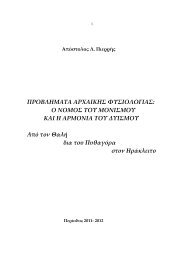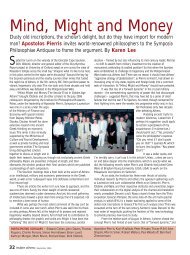APPENDIX C΄ ON DEPILATION: BODY COSMETICS IN CLASSICAL ...
APPENDIX C΄ ON DEPILATION: BODY COSMETICS IN CLASSICAL ...
APPENDIX C΄ ON DEPILATION: BODY COSMETICS IN CLASSICAL ...
Create successful ePaper yourself
Turn your PDF publications into a flip-book with our unique Google optimized e-Paper software.
<strong>ON</strong> DEPILATI<strong>ON</strong>: <strong>BODY</strong> <strong>COSMETICS</strong> <strong>IN</strong> <strong>CLASSICAL</strong> ANTIQUITY 575<br />
calling Paris apple‡Á·ÚÁÔÓ as referring to his rape of Helen as such). But<br />
all this may well be an (Alexandrian probably) example of philological<br />
obtuseness. Hesychius, the prince of the extant lexicographers, and the<br />
best source of accurate explanations for rare words and peculiar<br />
meanings, explains the Αrchilochian expression without any reference<br />
to eagles: M‹ Ù¢ ÌÂÏ·Ìapple‡ÁÔ˘ Ù‡¯ÔÈ˜Ø Ì‹ ÙÈÓÔ˜ àÓ‰Ú›Ԣ ηd åÛ¯˘ÚÔÜ<br />
Ù‡¯ÔȘ. He knows, of course, that apple‡Á·ÚÁÔ˜ is an Âr‰Ô˜ àÂÙÔÜ (s.v.);<br />
the fact is that apple‡Á·ÚÁÔ˜ was; ÌÂÏ¿Ìapple˘ÁÔ˜ was not. The Homeric<br />
eagle in Iliad Ω, 316 is described as ·åÂÙfiÓ… / ÌfiÚÊÓÔÓ ıËÚËÙÉÚ’, nÓ<br />
ηd appleÂÚÎÓeÓ Î·Ï¤Ô˘ÛÈÓ. The difficulty as to the precise meaning of<br />
ÌfiÚÊÓÔ˜ is well known. The Etym. Magnum s.v. proposes three<br />
derivations and corresponding meanings: from Ì¿ÚappleÙˆ, the snatcher,<br />
the catcher; from ùÚÊÓË, the dark-coloured, blackened; from ÌfiÚÔ˜<br />
and ÊfiÓÔ˜, the ÊfiÓÈÔ˜, murderous, deadly. Hesychius has an<br />
interesting note: ÌÔÚÊÓfiÓØ Âr‰Ô˜ àÂÙÔÜ. ηd Í·Óıfi˜. Significantly,<br />
Aristotle says that the name of this kind of eagle is appleÏ¿ÁÁÔ˜: Historia<br />
Anim. I, 618b23 sqq.: ≤ÙÂÚÔÓ ‰b Á¤ÓÔ˜ àÂÙÔÜ âÛÙdÓ n appleÏ¿ÁÁÔ˜<br />
ηÏÂÖÙ·È, ‰Â‡ÙÂÚÔ˜ ÌÂÁ¤ıÂÈ Î·d ÚÒÌFËØ ÔåÎÂÖ ‰b ‚‹ÛÛ·˜ ηd ôÁÎË Î·d<br />
Ï›ÌÓ·˜ (hence likely to appear by the Greek camp), âappleÈηÏÂÖÙ·È ‰b<br />
ÓËÙÙÔÊfiÓÔ˜ ηd ÌÔÚÊÓfi˜Ø Ôy ηd ≠OÌËÚÔ˜ ̤ÌÓËÙ·È âÓ ÙFÉ ÙÔÜ ÚÈ¿-<br />
ÌÔ˘ âÍfi‰ˇˆ (i.e. in our passage). And he continues immediately with:<br />
≤ÙÂÚÔ˜ ‰b ̤Ϸ˜ ÙcÓ ¯Úfi·Ó etc., which implies that the kind<br />
concerned is not ̤Ϸ˜; it could still be ÌÂÏ¿Ìapple˘ÁÔ˜, it is true, but if<br />
it was so against a light, Í·ÓıfiÓ background this would be<br />
characteristic enough to be mentioned, side by side with the apple‡Á·Ú-<br />
ÁÔ˜. Besides, appleÏ·ÁÁÒÓ was a wax item (esp. a girl’s toy or ornament),<br />
as is very well attested: v. Hesychius, Photius and Etym. M. s.v.;<br />
Scholia ad Theocr. II, 110; Callimachus, Hymn. in Cerer. 92 with the<br />
scholion; should we not then assume that appleÏ·ÁÁfi˜ means waxen in<br />
colour, that is, precisely Í·Óıfi˜? Perhaps the difficulty may be thought<br />
to lie with Homer’s nÓ Î·d appleÂÚÎÓeÓ Î·Ï¤Ô˘ÛÈÓ. But appleÂÚÎÓfi˜ does not<br />
really mean black; it refers mainly to the ripening of the fruit,<br />
especially of grapes, to the darker hues assumed in this process by it; it<br />
does not even so much signify the dark or dusky as such but rather<br />
what is deeper and more ripe relative to something else. Like the word<br />
shade it can apply to anything from deep dark through dim to even<br />
the slightest shading in a drawing. And like the word deep, it does not<br />
indicate certain colours, but rather a darker tint even of the same










